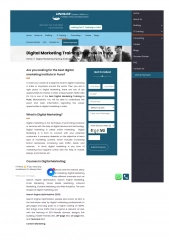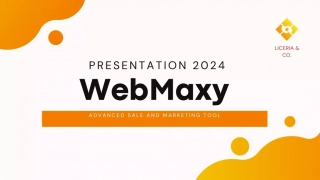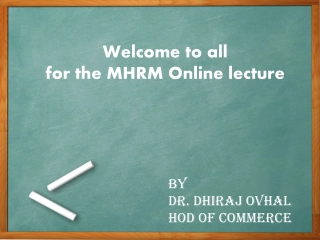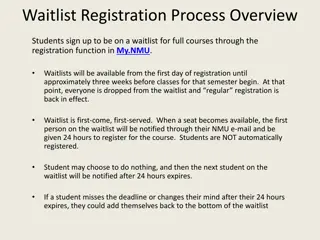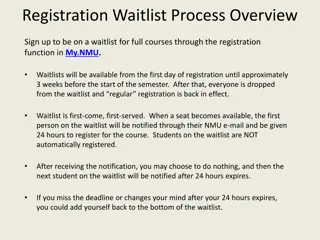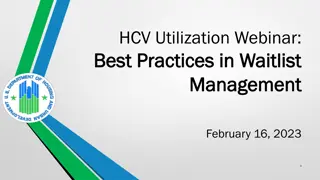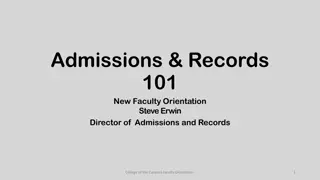
HUD Fair Housing Policy Priorities for Segregation and Discrimination in PBRA Properties
Explore HUD's Office of Fair Housing and Equal Opportunity priorities for addressing segregation and discrimination in HUD-subsidized properties, particularly under the PBRA program. Learn about efforts to combat disparities based on race, color, national origin, and more to promote fair housing practices.
Download Presentation

Please find below an Image/Link to download the presentation.
The content on the website is provided AS IS for your information and personal use only. It may not be sold, licensed, or shared on other websites without obtaining consent from the author. If you encounter any issues during the download, it is possible that the publisher has removed the file from their server.
You are allowed to download the files provided on this website for personal or commercial use, subject to the condition that they are used lawfully. All files are the property of their respective owners.
The content on the website is provided AS IS for your information and personal use only. It may not be sold, licensed, or shared on other websites without obtaining consent from the author.
E N D
Presentation Transcript
Policy Priorities of HUDs Office of Fair Housing and Equal Opportunity Gregory Crespo Director, Program Standards and Compliance October 27, 2022
PBRA Fair Housing Policy Priorities Segregation in PBRA properties More than 1.5 million HUD-subsidized multifamily units nationwide in over 36,000 multifamily properties including under PBRA, Section 202, and Section 811 A White family living in a PBRA unit is more than three times as likely to live in a low-poverty neighborhood as a Black family living in a PBRA unit.1 Marketing, Application Procedures, Waitlist Management Guidance on Compliance with Title VI of the Civil Rights Act in Marketing and Application Processing at Subsidized Multifamily Properties April 21, 2022 HUD Criminal Records Review AFHMP Form Amendments 1. The Center on Budget and Policy Priorities, Realizing the Housing Voucher Program s Potential to Enable Families to Move to Better Neighborhoods, 2016 (Table A-2). 2
FHEO Fair Housing Authorities Title VIII - The Fair Housing Act On the basis of (protected classes): race, color, national origin, religion, disability, familial status and sex including gender identity and sexual orientation Title VI On the basis of (protected classes) race, color, and national origin In programs or activities receiving federal financial assistance Section 504 of the Rehabilitation Act of 1973 On the basis of (protected class) disability In programs or activities receiving federal financial assistance The Americans with Disabilities Act (ADA) On the basis of (protected class) disability 3
Segregation in PBRA properties Marketing, application processing, and waitlist management practices can limit access to eligible housing-seekers and contribute to segregation of HUD- subsidized properties and disparate outcomes by race, color, national origin, and other protected classes 4
Segregation in PBRA properties Discrimination that can lead to or perpetuate segregation may include Intentional discrimination Discriminatory effects discrimination facially neutral policy or practice disproportionately affects members of a group identified by protected class recipient s policy or practice lacks a substantial legitimate justification, and where one or more alternatives would serve the same legitimate objectives but with less disproportionate effect on the basis of protected class 5
Marketing Marketing practices should aim to ensure that all applicable protected class groups in a marketing area have knowledge of and an opportunity to rent units in a particular building. When protected class groups are underrepresented at a property compared to their representation among qualified housing-seekers in the market area, housing providers should evaluate their marketing efforts contribution to that result and consider alternatives. Following slides based on Guidance on Compliance with Title VI of the Civil Rights Act in Marketing and Application Processing at Subsidized Multifamily Properties April 21, 2022 6
Marketing Best practices Community Contacts Use variety of community contacts, media, and social media, covering a broad geographic area - low-cost and can provide sufficiently detailed information Distribute detailed flyers and blank applications to local organizations social service providers (e.g., foodbanks, legal-aid offices, emergency shelters, health clinics), employers, advocacy organizations and other agencies, local governmental offices, housing authorities, and community gathering places (e.g., senior centers, recreation centers, libraries, schools, and places of worship). Community Contact helpful for LEP populations 7
Marketing Best practices Digital and Traditional Media Use a variety of Digital Media Maintaining a web or mobile site with clear information about availability, eligibility, and application processes - low-cost Social media, local listservs and other sites relevant to housing-seekers in the market area (including registries of affordable housing maintained by local governments, housing authorities, or community organizations) Use a variety of Traditional media Local radio stations, newspapers, and newsletters Advertisements in public places, such as buses, trains, and billboards 8
Marketing Not Best Practices that May Lead to Discrimination Only word-of-mouth marketing Only referrals from a single community organization or small number of community organizations that serve limited or targeted populations Only placing for rent signs at a property 9
Marketing Best practices Limited English Proficiency Recipients must take reasonable steps to ensure meaningful access for individuals with limited English proficiency (LEP) Failure to provide meaningful access to LEP individuals can be a form of national origin discrimination that violates Title VI. Evaluate LEP population in the market area Identify language assistance services, including translated materials Advertising in non-English language media when appropriate Use voice mail menu in the most common languages encountered Provide info about language assistance services and how to get them 10
Marketing Best practices Timing and Clarity Marketing efforts should commence well before any waitlist opening, such as sixty days before, to have a meaningful effect on reducing disparities Clear and consistent information including descriptions of amenities, eligibility criteria, rent, how to obtain and submit applications, and tenant selection (e.g., by lottery according to preferences). 11
Marketing Best Practices Welcoming of All Written and designed to convey that all applicants are welcome regardless of their race, color, national origin, or other protected class. Be aware of name, logo, location, or reputation that may suggest affiliation with a particular group (e.g., a religious reference) or other limitation on applicants and make affirmative efforts overcome perception. Such efforts may include prominent statement that the property is not limited and welcomes applicants of all backgrounds images of diverse models and other visual content that conveys that the property is actively seeking a diverse applicant pool 12
Application Procedures Acceptance Time and Place Requiring applications to be picked up and/or submitted in person unjustifiably excluding potential applicants who cannot travel to the property because they do not live in the neighborhood have inflexible work schedules or caretaking responsibilities rely on limited transportation options have mobility disabilities Distributing and/or accepting applications during a narrow window of time 13
Application Procedures Distribution and Acceptance Methods Broad distribution and acceptance can reduce disparities and promote equitable housing opportunity Ease of digital communication making available on website - including mobile version distributing to community contacts throughout the market area Accept through a variety of methods in-person, mail, web-based forms, and email picked-up and dropped off outside of regular business hours, including evenings and weekends, ideally at multiple locations. 14
Application Procedures Lottery Placing applicants on a waitlist pursuant to lottery rather than by prioritizing those who are first to apply is similarly likely to yield a more diverse tenant body, particularly when there is very high demand for the property. Clear Communication How to submit How will be prioritized and selected Explain procedure for requesting a reasonable accommodation Assess whether application processing requirements are perpetuating segregation or unjustifiably restricting access to the housing 15
Applicant Screening and Waitlist Management Screening Criteria: Criminal Records, Credit, Rental History May unjustifiably exclude individuals based on protected class HUD Criminal Records Guidance: housing providers should not rely on arrest records should consider the nature, severity, and recency of conviction records, as well as extenuating circumstances Rental History, housing providers should consider the accuracy, nature, relevance, and recency of negative information should not have any negative information trigger automatic denial 16
Applicant Screening and Waitlist Management Screening policies should be available to prospective applicants and contain enough detail to tell whether applicant is likely to qualify Housing providers should not request or consider records of criminal activity or rental history that fall outside the scope of their stated policies Housing providers who utilize a third-party tenant screening service should ensure that screenings are conducted in accordance with all tenant selection policies. 17
Applicant Screening and Waitlist Management Preferences - Generally Can significantly restrict access to housing opportunities in a discriminatory manner Especially when demand is high - persons without a preference have little to no chance of obtaining housing Should be considered in light of existing patterns of residential segregation and past discriminatory practices Must clearly inform all applicants about available preferences Must not operate in a manner contrary to civil rights protections Geographic preferences require HUD approval 18
Applicant Screening and Waitlist Management Preferences - Mechanics of application can be discriminatory In many areas, residents experiencing housing insecurity or homelessness are disproportionately people of color Limitations on proof accepted to establish residency disadvantage applicants living in housing insecurity e.g., requiring lease or mail with the applicant s name and current address may disadvantage applicants staying with friends or family, moving frequently, sleeping in shelters or their car, receiving mail at a P.O. box, etc. Similarly, need clarity around when applicants must live in a jurisdiction to qualify for a residency preference 19
Applicant Screening and Waitlist Management Waitlist Management Updating and removing applicant names Applicants experiencing housing insecurity or homelessness may have difficulty if stable mailing address is required Removing applicants if mail is returned as undeliverable without other attempt to reach applicant can disadvantage applicants who are transient Best Practice = Allow applicants choice of how they would like to be contacted: mail, email, phone, or all three 20
Applicant Screening and Waitlist Management Clear communication key to non-discriminatory practices Detailed information in English and non-English languages should be available to potential applicants about screening criteria and preferences What information may be requested and reviewed? How may applicants contest adverse determinations? How might property may contact applicant? What is required to remain active on the waitlist? Keep records to evaluate the impact of screening criteria, preferences, and waitlist management practices such as applications, requests for information, decisions, appeals 21





